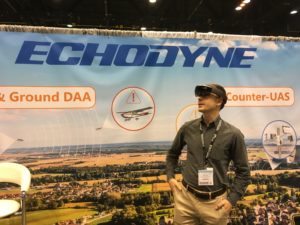 This is one of the coolest things we got to experience at this year’s AUVSI Xponential: finding a drone in the sky through Hololens augmented reality glasses.
This is one of the coolest things we got to experience at this year’s AUVSI Xponential: finding a drone in the sky through Hololens augmented reality glasses.
Here it is: imagine that you’ve secured an area of airspace around your drone operation. The Echodyne system has identified a drone in the airspace. Now, you need to find it in the sky – and learn all there is to know about the aircraft, identifying it as friend or foe.
With this reference architecture displayed by Echodyne, you just turn your head. Wearing the Hololens augmented reality headset, you follow the arrows in your field of vision until you find the drone in the sky – then twitch your fingers and see all of the data the system holds on that aircraft. It’s a stunning demonstration of the possiblities of data visualization.
Echodyne is an airspace security firm established in 2014, with blue chip investment from Bill Gates, among others. They use a combination of sensors, combined with a sophisticated software platform to allow stakeholders like law enforcement, federal agencies or enterprise companies to see exactly what is in their airspace, including drones. While small, lightweight radar systems are a main component of the detection system, they aren’t the only piece. “Radar is a great primary sensor,” says Leo McCloskey, Echodyne’s VP of Marketing. “But you need other sensors, like cameras, to be able to positively identify objects in the airspace.”
While they provide ready to deploy systems, they’re a technology company: applying AI and machine learning to process airspace data and classify objects – to distinguish, for example, between a bird and a Mavic-sized drone. The first generation machine learning platform can differentiate between drone and bird at 300-400 meters, but that’s just a start. “As the machine learning improves,” explains McCloskey, “the system should be able to detect and differentiate at full range.”
This week, Echodyne brought the Hololens to the exhibit floor to demonstrate a ground-breaking way of understanding the airspace information that the system provides. It’s augmented reality, with a layer of interactive data – for example, the system might identify a drone in the airspace by providing a green pointer around a drone that is part of your secure commercial operation, and a red pointer around an aircraft that is not authorized in the space.
Echodyne is partnering with law enforcement and security agencies to secure major events all around the country, but the system has many civil applications too. With an evidence-based detection and security platform, law enforcement agencies or corporations have the tools they need for prosecution, which is currently the primary legal means of drone mitigation. “Airspace Security” has emerged as a major theme of this year’s conference – and the Echodyne platform is ready to go.
The following is from an Echodyne press release.
Company that is Reinventing Radar Takes Airspace Safety to a New Level
CHICAGO, IL – April 29, 2019 – Echodyne, the manufacturer of innovative, high- performance, small electronically scanned array (ESA) radars for government and commercial markets, announced today that it will demonstrate enhanced airspace situational awareness by visualizing EchoGuard sensor data through augmented reality at AUVSI XPONENTIAL 2019 in Chicago, IL. The Company will showcase the technology at Booth #2805 on April 30th-May 2nd.
During the conference, Echodyne will display how its EchoGuard radar offers superior performance for both primary UAS use cases: commercial mission safety, and counter- UAS. The demonstration will feature an AR interactive experience using Microsoft’s Hololens and allows participants to experience unprecedented airspace situational awareness.
Echodyne has quickly emerged as the preferred airspace situational awareness provider with its small, commercially-priced ESA radar– the first of its kind in the industry. Recently, the Company affirmed its participation in a number of initiatives at UAS Centers of Excellence across the country, including NASA’s Unmanned Traffic Management (UTM) Technical Capability Level (TCL), FAA’s UTM Pilot Program (UPP) and FAA’s UAS Integration Pilot Program (IPP).
“Having the ability to demonstrate how our EchoGuard radar contributes to airspace safety at the premier conference for the unmanned systems industry is just another exciting step for Echodyne,” said Eben Frankenberg, CEO of Echodyne. “This is another example of Echodyne delivering innovation that enhances both mission and public safety.”

Miriam McNabb is the Editor-in-Chief of DRONELIFE and CEO of JobForDrones, a professional drone services marketplace, and a fascinated observer of the emerging drone industry and the regulatory environment for drones. Miriam has penned over 3,000 articles focused on the commercial drone space and is an international speaker and recognized figure in the industry. Miriam has a degree from the University of Chicago and over 20 years of experience in high tech sales and marketing for new technologies.
For drone industry consulting or writing, Email Miriam.
TWITTER:@spaldingbarker
Subscribe to DroneLife here.







[…] Augmented reality functionality helps provide drone operators with additional situational awareness. “SmartCam3D® overlays valuable geospatial data such as Street Vectors, Road Names, Points of Interest, Polygons, and other pertinent map entities onto real-time, full-motion-video (FMV) provided by the ANAFI USA’s powerful 4K HDR video, 32x zoom, and live video streaming capabilities – providing mission personnel with advanced situational awareness as they perform critical drone operations,” says the release. “SmartCam3D® also allows end-users to interact with live drone video in the same ways they would a map display, such as dropping a pin to mark a location or geocoding a selection from the real-time video stream. These powerful situational awareness capabilities present opportunities across a variety of mission-sets ranging from Airborne Law Enforcement, Insurance, and Industrial Inspections, to natural disaster response, Real Estate, and search and rescue operations.” […]